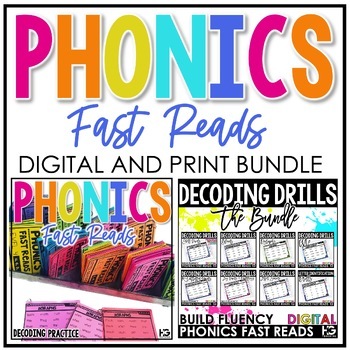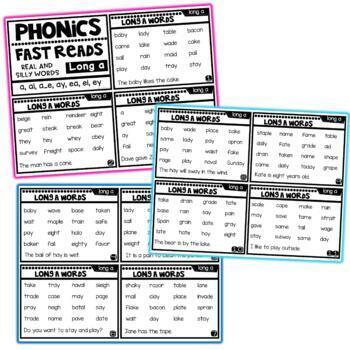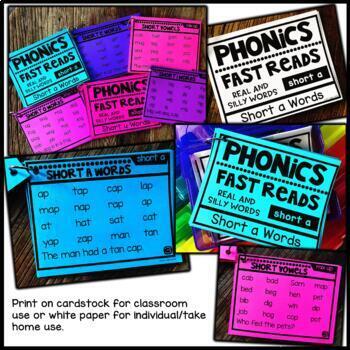Phonics Fast Reads| Decoding Drills with Real & Nonsense Word Fluency | Digital
- Zip
- Google Apps™
- Internet Activities
- Easel Activity

What educators are saying
Products in this Bundle (20)
showing 1-5 of 20 products
Description
These digital and print decoding drills offer an extra layer of phonics intervention and instruction to support your students who are struggling with fluency. If your students need extra practice decoding words, Phonics Fast Reads are for YOU! Students move through the drills at their own pace, increasing their speed and confidence as they go. This digital version includes print, google slides, and Seesaw. Click on the individual units for a more in depth look at what is included in this bundle.
Read about how I use these Fast Reads in my classroom HERE!
How can I use these drills in my classroom?
- Use with individual students.
- Use as a warmup during your targeted small group reading instruction.
- You can assign in Seesaw and Google classroom, allowing students to record themselves reading.
- Use as a partner activity.
- Use these in a literacy center!
Why did I create these Fast Reads?
I created these cards for the first-grade students in my own classroom. After introducing a new phonics pattern my students need practice reading and applying what they have learned to improve fluency.
The Research
I created these Fast Reads to improve reading fluency. According the the National Reading Panel, a few things are critical of good reading instruction.
- Explicit instruction in phonemic awareness
- Systematic phonics instruction
- Methods to improve fluency
Letter Recognition and Identification
The first set of Fast Reads reinforces letter names. At each level, students are introduced to four new letters. As students master the letter names, they move up a level and four new letters are given. A spiral review is given at the end of each level. These letter task cards are designed to be used in conjunction with the letter sound cards so that students begin to blend and segment words right away.
Letter Sounds
The Letter Sounds Phonics Fast Reads are introduced in a sequence that promotes blending and segmenting words as soon as possible. Right away, students learn that letters and combinations of letters make up sounds and words. As students master a level, they move to the next. Each level introduces four new letter sounds and reviews the previous sounds learned. There are seven levels total. The letter sound cards are perfect for those students who are just learning or struggling to identify and blend letter sounds quickly and automatically.
Short Vowels
These Short Vowel Phonics Fast Reads are perfect for children who are just beginning to read cvc words or those students who are struggling to decode quickly. Each Fast Read focuses on a short vowel sound and is introduced in a sequence that builds confidence. Students begin by reading short vowel word families. These word families allow students to decode quickly by only having to manipulate the first letter. After reading the word families, students must read a mix up of words with the same vowel sound. The last Fast Read in this bundle includes a mix up of all short vowel sounds! These phonics fast reads work to move students from slowly blending cvc words to a level where decoding is habitual and automatic.
CVCe
These CVCe Phonics Fast Reads are perfect for children who are just beginning to read CVCe words or those students who are struggling to decode quickly. Each Fast Read focuses on a specific long vowel. The last Fast Read in this bundle includes a mix up of all CVCe words! These phonics fast reads are designed to move students from slowly blending words to a level where decoding is habitual and automatic.
Long Vowels, Tricky Vowels, Vowel Teams, Diphthongs
These Phonics Fast Reads are perfect for students who are learning to read and write words with tricky vowel spelling patterns. Each Fast Read focuses on a specific phoneme and includes all of the various spelling patterns that make that phoneme. These phonics drills and repeated readings are designed to move students from slowly blending words to a level where decoding is habitual and automatic. The word sort is an added bonus!
R-Controlled Vowels
These Phonics Fast Reads are perfect for students who are learning to read and write words with the tricky bossy r spelling pattern. Each Fast Read includes real and nonsense words and comes with a word sort activity.
Digraphs
The Digraphs Phonics Fast Reads are perfect for students who are learning to read and write words with digraphs.
Blends
These Phonics Fast Reads are perfect for students who are learning to read and write words with consonant blends. Each Fast Read includes real and nonsense words and comes with an optional paper/pencil word sort activity.





